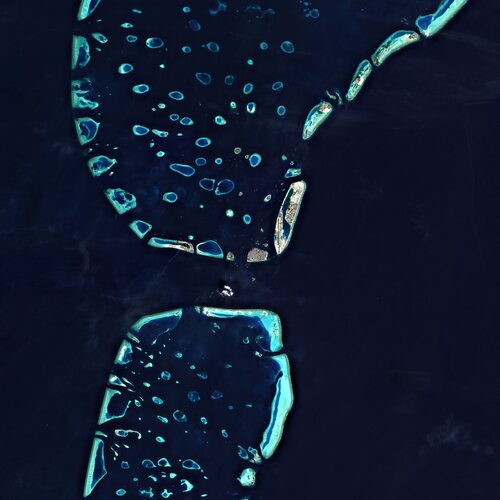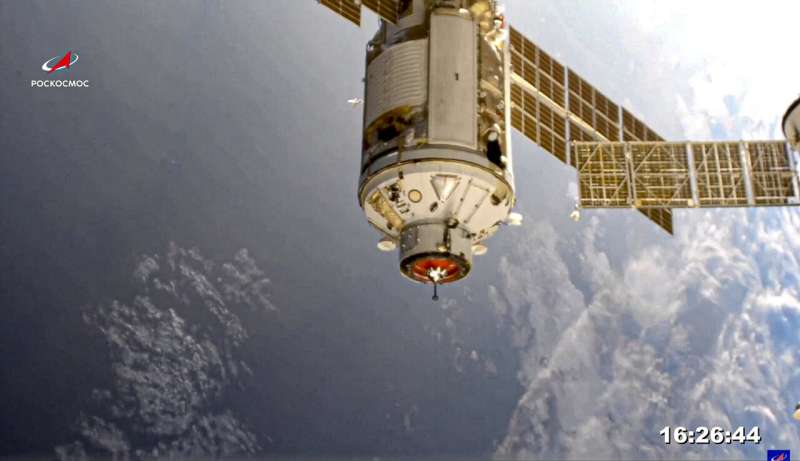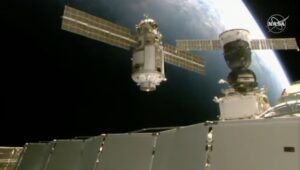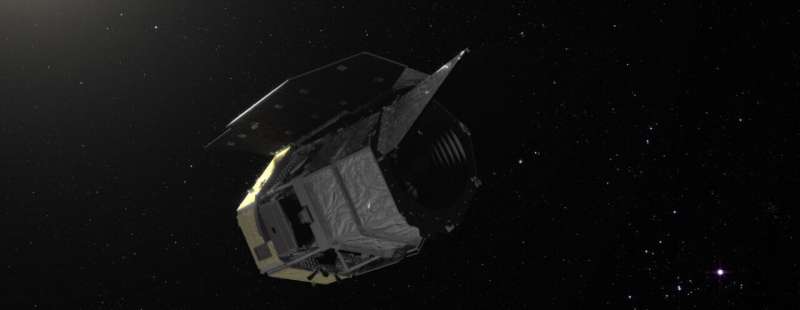Two more Artemis I deep space cubesats prepare for launch
Friday, 30 July 2021 09:49 Two additional secondary payloads that will travel to deep space on Artemis I, the first flight of the Space Launch System (SLS) rocket and Orion spacecraft, are ready for launch.
The Team Miles and EQUilibriUm Lunar-Earth point 6U Spacecraft (EQUULEUS) CubeSats are tucked into dispensers and installed in the Orion stage adapter - the ring that connects Orion to the SLS rocket. They are jo
Two additional secondary payloads that will travel to deep space on Artemis I, the first flight of the Space Launch System (SLS) rocket and Orion spacecraft, are ready for launch.
The Team Miles and EQUilibriUm Lunar-Earth point 6U Spacecraft (EQUULEUS) CubeSats are tucked into dispensers and installed in the Orion stage adapter - the ring that connects Orion to the SLS rocket. They are jo Inmarsat unveils the communications network of the future
Friday, 30 July 2021 09:49 Inmarsat has unveiled plans for ORCHESTRA, the communications network of the future. In the largest ever transformation of its current world-class services, Inmarsat ORCHESTRA will bring together existing geosynchronous (GEO) satellites with low earth orbit satellites (LEO) and terrestrial 5G into an integrated, high-performance solution.
Whether for a ship in a crowded port, an aircraft p
Inmarsat has unveiled plans for ORCHESTRA, the communications network of the future. In the largest ever transformation of its current world-class services, Inmarsat ORCHESTRA will bring together existing geosynchronous (GEO) satellites with low earth orbit satellites (LEO) and terrestrial 5G into an integrated, high-performance solution.
Whether for a ship in a crowded port, an aircraft p Space company in search for professionals
Friday, 30 July 2021 09:49 Despite the exceptional economic situation caused by the pandemic, space industry is showing an upward trend. New ways of working, new ways of collaboration and new, hybrid events promote digital technologies for worldwide communication and data transmission and thus also increase the demand for future-oriented solutions.
Such as made possible by the space company TESAT in Backnang near St
Despite the exceptional economic situation caused by the pandemic, space industry is showing an upward trend. New ways of working, new ways of collaboration and new, hybrid events promote digital technologies for worldwide communication and data transmission and thus also increase the demand for future-oriented solutions.
Such as made possible by the space company TESAT in Backnang near St Redwire to demonstrate In-Space Additive Manufacturing on ISS for Lunar operations
Friday, 30 July 2021 09:49 Redwire reports that it is launching new manufacturing hardware to the International Space Station (ISS) that will demonstrate additive manufacturing processes using lunar regolith simulant. This demonstration is critical to advancing the ability to develop a permanent presence for humankind on the Moon using in-situ resources.
This will be the first time that lunar regolith simulant has b
Redwire reports that it is launching new manufacturing hardware to the International Space Station (ISS) that will demonstrate additive manufacturing processes using lunar regolith simulant. This demonstration is critical to advancing the ability to develop a permanent presence for humankind on the Moon using in-situ resources.
This will be the first time that lunar regolith simulant has b Clays, not water, are likely source of Martian lakes
Friday, 30 July 2021 09:49 Where there's water, there's life. That's the case on Earth, at least, and also why scientists remain tantalized by any evidence suggesting there's liquid water on cold, dry Mars. The Red Planet is a difficult place to look for liquid water: While water ice is plentiful, any water warm enough to be liquid on the surface would last for only a few moments before turning into vapor in Mars' wispy a
Where there's water, there's life. That's the case on Earth, at least, and also why scientists remain tantalized by any evidence suggesting there's liquid water on cold, dry Mars. The Red Planet is a difficult place to look for liquid water: While water ice is plentiful, any water warm enough to be liquid on the surface would last for only a few moments before turning into vapor in Mars' wispy a Earthly rocks point way to water hidden on Mars
Friday, 30 July 2021 09:49 A combination of a once-debunked 19th-century identification of a water-carrying iron mineral and the fact that these rocks are extremely common on Earth, suggests the existence of a substantial water reservoir on Mars, according to a team of geoscientists.
"One of my student's experiments was to crystalize hematite," said Peter J. Heaney, professor of geosciences, Penn State. "She came up
A combination of a once-debunked 19th-century identification of a water-carrying iron mineral and the fact that these rocks are extremely common on Earth, suggests the existence of a substantial water reservoir on Mars, according to a team of geoscientists.
"One of my student's experiments was to crystalize hematite," said Peter J. Heaney, professor of geosciences, Penn State. "She came up SwRI team zeroes in on source of the impactor that wiped out the dinosaurs
Friday, 30 July 2021 09:49 The impactor believed to have wiped out the dinosaurs and other life forms on Earth some 66 million years ago likely came from the outer half of the main asteroid belt, a region previously thought to produce few impactors.
Researchers from Southwest Research Institute have shown that the processes that deliver large asteroids to Earth from that region occur at least 10 times more frequentl
The impactor believed to have wiped out the dinosaurs and other life forms on Earth some 66 million years ago likely came from the outer half of the main asteroid belt, a region previously thought to produce few impactors.
Researchers from Southwest Research Institute have shown that the processes that deliver large asteroids to Earth from that region occur at least 10 times more frequentl Airbus completes integration of 3rd Copernicus Sentinel-2
Friday, 30 July 2021 09:49 Airbus has finished the integration of the Copernicus Sentinel-2C satellite. It is the third of its kind and will now be shipped to Munich to undergo extensive environmental tests to prove its readiness for space. The test campaign will last until March 2022.
The data gathered by Sentinel-2 satellites are used for monitoring land use and changes, soil sealing, land management, agriculture,
Airbus has finished the integration of the Copernicus Sentinel-2C satellite. It is the third of its kind and will now be shipped to Munich to undergo extensive environmental tests to prove its readiness for space. The test campaign will last until March 2022.
The data gathered by Sentinel-2 satellites are used for monitoring land use and changes, soil sealing, land management, agriculture, World's first re-progammable commercial satellite set to launch
Friday, 30 July 2021 07:04
The European Space Agency will on Friday launch the world's first commercial fully re-programmable satellite, paving the way for a new era of more flexible communications.
Unlike conventional models that are designed and "hard-wired" on Earth and cannot be repurposed once in orbit, the Eutelsat Quantum is based on so-called software-defined technology that allows users to tailor the communications to their needs—almost in real-time.
"When a satellite is launched, demand and markets can change over time," Elodie Viau, the agency's telecommunications and applications director, told AFP recently.
"A satellite that is not 'fixed' and can adapt to customers gives us better prospects."
A successful launch would pave the way for mass production of the satellites, which have so far been one-offs.
The Quantum will be part of the payload for an Ariane 5 rocket due to launch from the Guiana Space Centre in Latin America between 21:00 and 22:30 GMT on Friday.
In addition to the Quantum, to be operated by Paris-based Eutelsat, the rocket will also deploy a conventional satellite for Brazil's Embratel.
Because it can be reprogrammed while orbiting in a fixed position 35,000 kilometres (22,000 miles) above the Earth, the Quantum can respond to changing demands for data transmission and secure communications during its 15-year lifetime, ESA said.
Earth from Space: Malé, the Maldives
Friday, 30 July 2021 07:00
The Copernicus Sentinel-2 mission takes us over Malé – the capital and most populous city in the Republic of Maldives.
New Russian lab briefly knocks space station out of position
Friday, 30 July 2021 06:45
Station loses attitude control after Nauka docking, Starliner launch delayed
Thursday, 29 July 2021 22:19
A Russian module that docked to the International Space Station July 29 started firing its thrusters hours later, briefly knocking the station out of its normal attitude and forcing NASA to delay a commercial crew test flight that was scheduled to launch July 30.
Biden taps Aerospace Corp.’s John Plumb to run DoD space policy
Thursday, 29 July 2021 18:15
President Biden has nominated John Plumb to be assistant secretary of defense for space policy, the White House announced July 29.
Ground system for NASA's Roman Space Telescope moves into development
Thursday, 29 July 2021 16:08
When it launches in the mid-2020s, NASA's Nancy Grace Roman Space Telescope will revolutionize astronomy by building on the science discoveries and technological leaps of the Hubble, Spitzer, and Webb space telescopes. The mission's wide field of view and superb resolution will enable scientists to conduct sweeping cosmic surveys, yielding a wealth of information about celestial realms from our solar system to the edge of the observable universe.
On July 23rd, the Roman Space Telescope successfully completed the critical design review of the mission's ground systems, which are spread over multiple institutions including the Space Telescope Science Institute (STScI) in Baltimore, Maryland; NASA's Goddard Space Flight Center in Greenbelt, Maryland; and Caltech/IPAC in Pasadena, California. STScI will host the Science Operations Center (SOC) while Goddard will provide the Mission Operations Center and Caltech/IPAC will house the Science Support Center. The passing of the critical design review means the plan for science operations provides all the necessary data processing and archiving capabilities. The mission will now proceed to the next phase: building and testing the newly designed systems that will enable planning and scheduling of Roman observations and managing the resulting data, anticipated to be over 20 petabytes (20,000,000 GB) within the first five years of operations.
Inmarsat unveils multi-orbit Orchestra constellation
Thursday, 29 July 2021 16:02
British operator Inmarsat plans to add at least 150 low-Earth-orbit satellites to its global fleet, stepping up competition against OneWeb and others developing megaconstellations for mobility markets.

